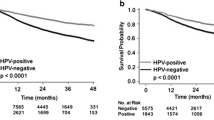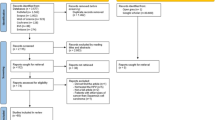Abstract
A subset of head and neck squamous cell carcinoma, which mainly arise from the crypt epithelium of the palatine and lingual tonsils, may be caused by high-risk human papillomavirus (HPV) infections. This topographical restriction together with other overlapping clinical features have led investigators to suspect that HPV plays a role in squamous cell carcinoma of unknown primary (SCCUP) site metastatic to neck lymph nodes. We performed a systematic review of articles listed in PubMed to identify studies testing HPV and/or p16INK4a status (p16) in tissue samples from initial and definitive SCCUP. The prevalence of HPV-related (HPV DNA-positive and/or p16 positive) SCCUP was calculated for all the SCCUP, initial SCCUP, suspected definitive SCCUP, and true definitive SCCUP whenever a minimum of 10 cases of each category was identified. In addition, data concerning patients’ diagnostic work-up, the HPV detection methods, and the correlations between HPV-status, the localization of the occult primary tumor, and the clinical outcome were also extracted. Eighteen retrospective cohort studies, assessing a total of 659 patients, met the inclusion criteria. The overall median prevalences of HPV-DNApos, of p16pos, and of positivity for both HPV markers were, respectively, 37.0, 48.5, and 36.0 %. Patients with diagnosis of initial SCCUP had overall median prevalences of HPV-DNApos, of p16pos, and of positivity for both HPV markers, respectively, of 81.8, 86.2, and 80.8 %. The data uncovered by this systematic review confirm that SCCUP is frequently causally associated to HPV-driven oropharyngeal squamous cell carcinomas. This finding supports the view that HPV-status could be routinely assessed in SCCUP patients as it may lead to identifying the primary tumor and the decision to de-escalate treatment.



Similar content being viewed by others
References
Ferlay J, Steliarova-Foucher E, Lortet-Tieulent J et al (2013) Cancer incidence and mortality patterns in Europe: estimates for 40 countries in 2012. Eur J Cancer 49:1374–1403
Leemans CR, Braakhuis BJ, Brakenhoff RH (2011) The molecular biology of head and neck cancer. Nat Rev Cancer 11:9–22
Cianchetti M, Mancuso AA, Amdur RJ et al (2009) Diagnostic evaluation of squamous cell carcinoma metastatic to cervical lymph nodes from an unknown head and neck primary site. Laryngoscope 119:2348–2354
Randall DA, Johnstone PA, Foss RD, Martin PJ (2000) Tonsillectomy in diagnosis of the unknown primary tumor of the head and neck. Otolaryngol Head Neck Surg 122:52–55
Strojan P, Ferlito A, Medina JE et al (2013) Contemporary management of lymph node metastases from an unknown primary to the neck: I. a review of diagnostic approaches. Head Neck 35:123–132
Mehta V, Johnson P, Tassler A et al (2013) A new paradigm for the diagnosis and management of unknown primary tumors of the head and neck: a role for transoral robotic surgery. Laryngoscope 123:146–151
Graboyes EM, Sinha P, Thorstad WL et al (2014) Management of human papillomavirus-related unknown primaries of the head and neck with a transoral surgical approach. Head Neck. doi:10.1002/hed.23800
Mozet C, Wichmann G, Stumpp P, Dietzsch S, Dietz A (2013) Zervikales CUP-syndrom. Onkologe 19(1):44–51
Straetmans J, Vent J, Lacko M et al (2015) Management of neck metastases of unknown primary origin united in two European centers. Eur Arch Otorhinolaryngol 272:195–205
Tribius S, Hoffmann AS, Bastrop S et al (2012) HPV status in patients with head and neck of carcinoma of unknown primary site: HPV, tobacco smoking, and outcome. Oral Oncol 48:1178–1184
Jensen DH, Hedback N, Specht L et al (2014) Human papillomavirus in head and neck squamous cell carcinoma of unknown primary is a common event and a strong predictor of survival. PLoS One 9:e110456
Park GC, Lee M, Roh JL et al (2012) Human papillomavirus and p16 detection in cervical lymph node metastases from an unknown primary tumor. Oral Oncol 48:1250–1256
Fotopoulos G, Pavlidis N (2015) The role of human papilloma virus and p16 in occult primary of the head and neck: a comprehensive review of the literature. Oral Oncol 51:119–123
Begum S, Gillison ML, Nicol TL, Westra WH (2007) Detection of human papillomavirus-16 in fine-needle aspirates to determine tumor origin in patients with metastatic squamous cell carcinoma of the head and neck. Clin Cancer Res 13:1186–1191
Chenevert J, Seethala RR, Barnes EL, Chiosea SI (2012) Squamous cell carcinoma metastatic to neck from an unknown primary: the potential impact of modern pathologic evaluation on perceived incidence of human papillomavirus-positive oropharyngeal carcinoma prior to 1970. Laryngoscope 122:793–796
Perkins SM, Spencer CR, Chernock RD et al (2012) Radiotherapeutic management of cervical lymph node metastases from an unknown primary site. Arch Otolaryngol Head Neck Surg 138:656–661
Keller LM, Galloway TJ, Holdbrook T et al (2014) p16 status, pathologic and clinical characteristics, biomolecular signature, and long term outcomes in unknown primary carcinomas of the head and neck. Head Neck 36:1677–1684
Demiroz C, Vainshtein JM, Koukourakis GV et al (2014) Head and neck squamous cell carcinoma of unknown primary: neck dissection and radiotherapy or definitive radiotherapy. Head Neck 36:1589–1595
Kobayashi K, Saito Y, Omura G et al (2014) Clinical features of human papilloma virus-related head and neck squamous cell carcinoma of an unknown primary site. ORL J Otorhinolaryngol Relat Spec 76:137–146
Strojan P, Ferlito A, Langendijk JA et al (2013) Contemporary management of lymph node metastases from an unknown primary to the neck: II. a review of therapeutic options. Head Neck 35:286–293
Boscolo-Rizzo P, Del Mistro A, Bussu F et al (2013) New insights into human papillomavirus-associated head and neck squamous cell carcinoma. Acta Otorhinolaryngol Ital 33:77–87
Ang KK, Harris J, Wheeler R et al (2010) Human papillomavirus and survival of patients with oropharyngeal cancer. N Engl J Med 363(24–35):23
Rietbergen MM, Leemans CR, Bloemena E et al (2013) Increasing prevalence rates of HPV attributable oropharyngeal squamous cell carcinomas in the Netherlands as assessed by a validated test algorithm. Int J Cancer 132:1565–1571
Hafkamp HC, Manni JJ, Haesevoets A et al (2008) Marked differences in survival rate between smokers and nonsmokers with HPV 16-associated tonsillar carcinomas. Int J Cancer 122:2656–2664
Goldenberg D, Begum S, Westra WH et al (2008) Cystic lymph node metastasis in patients with head and neck cancer: an HPV-associated phenomenon. Head Neck 30:898–903
Zengel P, Assmann G, Mollenhauer M et al (2012) Cancer of unknown primary originating from oropharyngeal carcinomas are strongly correlated to HPV positivity. Virchows Arch 461:283–290
Boscolo-Rizzo P, Gava A, Mosto M (2007) Carcinoma metastatic to cervical lymph nodes from an occult primary tumor: the outcome after combined-modality therapy. Ann Surg Oncol 14:1575–1582
Mollenhauer M, Assmann G, Zengel P et al (2014) HPV-assoziierte oropharyngeale Karzinome. Onkologe 20:599–614
Moher D, Liberati A, Tetzlaff J, Altman DG (2009) Preferred reporting items for systematic reviews and meta-analyses: the PRISMA statement. J Clin Epidem 62:1006–1012
Vent J, Haidle B, Wedemeyer I et al (2013) p16 expression in carcinoma of unknown primary: diagnostic indicator and prognostic marker. Head Neck 35:1521–1526
Sivars L, Nasman A, Tertipis N et al (2014) Human papillomavirus and p53 expression in cancer of unknown primary in the head and neck region in relation to clinical outcome. Cancer Med 3:376–384
Davis KS, Byrd JK, Mehta V et al (2014) Occult primary head and neck squamous cell carcinoma: utility of discovering primary lesions. Otolaryngol Head Neck Surg 151(272–278):33
Compton AM, Moore-Medlin T, Herman-Ferdinandez L et al (2011) Human papillomavirus in metastatic lymph nodes from unknown primary head and neck squamous cell carcinoma. Otolaryngol Head Neck Surg 145:51–57
Yasui T, Morii E, Yamamoto Y et al (2014) Human papillomavirus and cystic node metastasis in oropharyngeal cancer and cancer of unknown primary origin. PLoS One 9:e95364
Weiss D, Koopmann M, Rudack C (2011) Prevalence and impact on clinicopathological characteristics of human papillomavirus-16 DNA in cervical lymph node metastases of head and neck squamous cell carcinoma. Head Neck 33:856–862
Westra WH (2014) Detection of human papillomavirus (HPV) in clinical samples: evolving methods and strategies for the accurate determination of HPV status of head and neck carcinomas. Oral Oncol 50:771–779
Halec G, Schmitt M, Dondog B et al (2013) Biological activity of probable/possible high-risk human papillomavirus types in cervical cancer. Int J Cancer 132:63–71
Halec G, Holzinger D, Schmitt M et al (2013) Biological evidence for a causal role of HPV16 in a small fraction of laryngeal squamous cell carcinoma. Br J Cancer 109:172–183
Halec G, Alemany L, Lloveras B et al (2014) Pathogenic role of the eight probably/possibly carcinogenic HPV types 26, 53, 66, 67, 68, 70, 73 and 82 in cervical cancer. J Pathol 234:441–451
Ndiaye C, Mena M, Alemany L et al (2014) HPV DNA, E6/E7 mRNA, and p16INK4a detection in head and neck cancers: a systematic review and meta-analysis. Lancet Oncol 15:1319–1331
Kamposioras K, Pentheroudakis G, Pavlidis N (2013) Exploring the biology of cancer of unknown primary: breakthroughs and drawbacks. Eur J Clin Invest 43:491–500
Westra WH (2012) The morphologic profile of HPV-related head and neck squamous carcinoma: implications for diagnosis, prognosis, and clinical management. Head Neck Pathol 6(Suppl 1):S48–S54
Perry ME (1994) The specialised structure of crypt epithelium in the human palatine tonsil and its functional significance. J Anat 185:111–127
Jakscha J, Zlobec I, Storck C, Obermann EC, Tornillo L, Terracciano LM, Fischer CA (2013) The clinical impact of p16 status in fine-needle aspirates of cervical lymph node metastasis of head and neck squamous cell carcinomas. Eur Arch Otorhinolaryngol 270:661–667
Posner MR, Lorch JH, Goloubeva O et al (2011) Survival and human papillomavirus in oropharynx cancer in TAX 324: a subset analysis from an international phase III trial. Ann Oncol 22:1071–1077
Lassen P, Eriksen JG, Hamilton-Dutoit S et al (2009) Effect of HPV-associated p16INK4A expression on response to radiotherapy and survival in squamous cell carcinoma of the head and neck. J Clin Oncol 27:1992–1998
Licitra L, Perrone F, Bossi P et al (2006) High-risk human papillomavirus affects prognosis in patients with surgically treated oropharyngeal squamous cell carcinoma. J Clin Oncol 24:5630–5636
Bossi P, Orlandi E, Miceli R et al (2014) Treatment-related outcome of oropharyngeal cancer patients differentiated by HPV dictated risk profile: a tertiary cancer centre series analysis. Ann Oncol 25:694–699
van Wouwe M, de Bree R, Kuik DJ et al (2009) Shoulder morbidity after non-surgical treatment of the neck. Radiother Oncol 90:196–201
Begum S, Cao D, Gillison M et al (2015) Tissue distribution of human papillomavirus 16 DNA integration in patients with tonsillar carcinoma. Clin Cancer Res 11:5694–5699
Lyford-Pike S, Peng S, Young GD et al (2013) Evidence for a role of the PD-1:PD-L1 pathway in immune resistance of HPV-associated head and neck squamous cell carcinoma. Cancer Res 73:1733–1741
Acknowledgments
The authors would like to thank Prof. Annette Kopp-Schneider for her assistance in statistical analysis. Support by the DKFZ light microscopy facility is gratefully acknowledged. PBR has been awarded a scholarship from the DAAD (Deutsche Akademische Austauschdienst). We would also like to express thanks to the authors of the original studies who provided additional information for this review.
Author information
Authors and Affiliations
Corresponding author
Ethics declarations
Conflict of interest
MP received research funding from cooperation contracts with DKFZ, with Roche and Qiagen. He is also the inventor and receives royalties on patents held by DKFZ in the field of molecular diagnostics for infectious disease.
Electronic supplementary material
Below is the link to the electronic supplementary material.
Rights and permissions
About this article
Cite this article
Boscolo-Rizzo, P., Schroeder, L., Romeo, S. et al. The prevalence of human papillomavirus in squamous cell carcinoma of unknown primary site metastatic to neck lymph nodes: a systematic review. Clin Exp Metastasis 32, 835–845 (2015). https://doi.org/10.1007/s10585-015-9744-z
Received:
Accepted:
Published:
Issue Date:
DOI: https://doi.org/10.1007/s10585-015-9744-z




